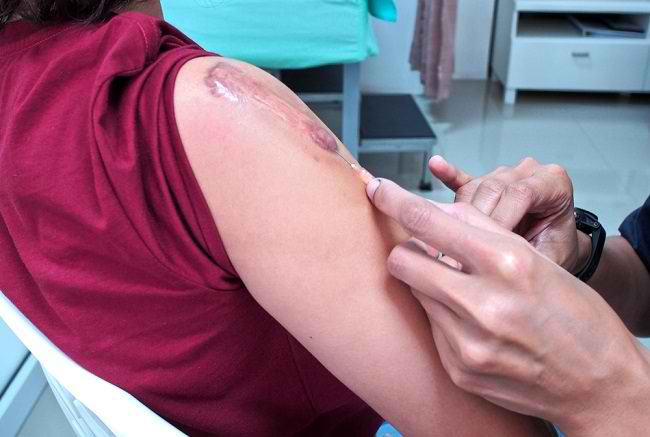Know Keloid Injections
One of the common ways to deal with keloids is keloid injection. In this procedure, the doctor will inject corticosteroids directly into the keloid, which is a scar in the form of scar tissue that grows protruding and wider than the original wound.
When the skin is injured, the body's cells will naturally form scar tissue to cover and heal the wound. However, in patients with keloids, scar tissue is overgrown to exceed the injured area. Keloids can look like pink bumps with a smooth surface. 
How it Works and the Effects of Keloid Injection
Corticosteroid medications used in the keloid injection procedure can help reduce size and improve the appearance of keloids in several ways. The following is the explanation.- Corticosteroids can reduce the process of inflammation (inflammation) that occurs in keloids by inhibiting the movement of white blood cells, such as monocytes and phagocyte cells, to the wound area. This can prevent worsening of keloid symptoms, such as itching and pain.
- Corticosteroids can prevent existing fibroblast cells from forming more fibroblast cells. These fibroblasts are scar tissue cells.
- Corticosteroids can inhibit the development of keratinocyte cells, which produce solid proteins in the skin, and slow down the process of new skin epithelial cell growth in keloids.
- Corticosteroids can inhibit the formation of new collagen in keloid tissue and maintain the action of the collagenase enzyme in breaking down the collagen that has already formed.
Keloid Inject Procedure
Corticosteroid medication will be injected directly into the problematic area (intralesional injection), which is keloid tissue. The following are the steps in the keloid injection procedure:
- The doctor will clean the keloid and the surrounding area with antiseptic fluid, before injecting corticosteroid medication. This aims to prevent bacterial infections at the injection site.
- Corticosteroid drug fluids can be given with or without dilution. Dilution can be done using saline solution or anesthetic to reduce pain.
- Corticosteroids will be immediately injected into the keloid bulge using a fine needle.
- Injections will be repeated regularly every month or every few months.
Keloid Injecting Side Effects
Although relatively safe, keloid injections can still cause side effects in the form of local reactions in the keloid area only or broader (systemic) reactions. Here are some side effects of keloid injection:
- Telangiectasis, characterized by the appearance of fine red streaks in the keloid area due to dilation of the small blood vessels beneath
- Thinning and damage to skin tissue and fat tissue under the skin (atrophy)
- Changes in skin pigmentation, so that the skin in the injection area will be darker or lighter in color than the surrounding skin
- Bleeding, wounds, and infections of the skin
- Cushing's syndrome is due to an increase in the amount of cortisol in the body
Keloids generally cannot disappear by themselves, they can even continue to grow. Therefore, if you have keloids and want to get rid of them, consult a dermatologist to find out if your keloids can be treated with keloid injections or need another treatment.
In addition, to prevent keloids from getting worse, you are also advised to protect them from exposure to sunlight and friction with clothing.
Written by:
dr. Irene Cindy Sunur
Label : Health
Comments
Post a Comment